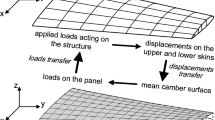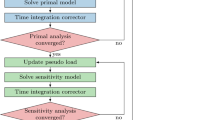Abstract
The sensitivity analysis of static aeroelastic loads can be analytically performed by virtue of a modified stiffness matrix. However, introducing a modified stiffness matrix into the calculation will incur extra computational cost. Additionally, the intrinsic drawback of the direct method is disadvantageous for the sensitivity calculation with a large number of design variables. This paper therefore presents a novel iteration-based adjoint method for the sensitivity analysis of static aeroelastic loads acting on flexible wing, the basis of which is the static aeroelastic calculation via loosely coupled iteration between the potential-flow panel model and the structural linear finite element model. By using an iterative approach for evaluating the adjoint variable, modification to the original stiffness matrix can be obviated. Moreover, this method is more competent for the structural sensitivity analysis with a very large number of design variables, since the adjoint variable is unrelated to the designs. A rectangular wing and a swept wing are employed to demonstrate the verification of the algorithms. The design sensitivities of applied nodal forces on the structure, lift per unit span, total lift and root bending moment are calculated and analyzed. The computational cost is also discussed to further demonstrate the efficiency of the proposed method.























Similar content being viewed by others
References
Adelman HM, Haftka RT (1986) Sensitivity analysis of discrete structural systems. AIAA J 24(5):823–832
Arora JS, Haug EJ (1976) Efficient optimal design of structures by generalized steepest descent programming. Int J Numer Methods Eng 10(4):747–766
Arora JS, Haug EJ (1979) Methods of design sensitivity analysis in structural optimization. AIAA J 17(9):970–974
Beckert A, Wendland H (2001) Multivariate interpolation for fluid-structure-interaction problems using radial basis functions. Aerosp Sci Technol 5(2):125–134
Bookstein FL (1989) Principal warps: thin-plate splines and the decomposition of deformations. IEEE Trans Pattern Anal Mach Intell 11(6):567–585
Brown SA (1997) Displacement extrapolations for CFD+CSM aeroelastic analysis. In: 38th Structures, Structural Dynamics, and Materials Conference, pp 291–300
Bryson AE, Ho Y-C (1975) Applied optimal control: optimization, estimation, and control. John Wiley & Sons, New York
Chen PC, Sarhaddi D, Liu DD (2000) Transonic-aerodynamic-influence-coefficient approach for aeroelastic and MDO applications. J Aircr 37(1):85–94
Choi KK, Kim NH (2005) Structural sensitivity analysis and optimization 1: linear systems. Springer, New York
Davis TA (2006) Direct methods for sparse linear systems. SIAM, Philadelphia
Duff IS, Erisman AM, Reid JK (2017) Direct methods for sparse matrices, 2nd edition. Oxford University Press, Oxford
Dutto L, Lepage C, Habashi W (1999) Impact of storage of sparse linear systems on CFD computations. In: 37th Aerospace Sciences Meeting and Exhibit, pp 1–9
Farhat C, Lesoinne M, Tallec PL (1998) Load and motion transfer algorithms for fluid/structure interaction problems with non-matching discrete interfaces: momentum and energy conservation, optimal discretization and application to aeroelasticity. Comput Methods Appl Mech Eng 157(1-2):95–114
Farhat C, Lesoinne M, Maman N (1995) Mixed explicit/implicit time integration of coupled aeroelastic problems: three-field formulation, geometric conservation and distributed solution. Int J Numer Methods Fluids 21(10):807–835
George A, Liu J W-H (1981) Computer solution of large sparse positive definite systems. Prentice-Hall, Englewood Cliffs
Ghattas O, Li X (1998) Domain decomposition methods for sensitivity analysis of a nonlinear aeroelasticity problem. Int J Comput Fluid Dyn 11(1-2):113–130
Giesing JP, Kalman TP, Rodden WP (1976) Correction factor techniques for improving aerodynamic prediction methods. NASA CR-144967
Greenbaum A, Chartier TP (2012) Numerical methods: design, analysis, and computer implementation of algorithms. Princeton University Press, Princeton
Gupta KK, Meek JL (2003) Finite element multidisciplinary analysis, 2nd edition. AIAA, Reston
Harder RL, Desmarais RN (1972) Interpolation using surface splines. J Aircr 9(2):189–191
Haug EJ, Arora JS (1978) Design sensitivity analysis of elastic mechanical systems. Comput Methods Appl Mech Eng 15(1):35–62
Horn RA, Johnson CR (1985) Matrix analysis. Cambridge University Press, New York
Hou G, Satyanarayana A (2000) Analytical sensitivity analysis of a static aeroelastic wing. In: 8th Symposium on Multidisciplinary Analysis and Optimization, pp 1–15
Intel (2017) Intel math kernel library developer reference. MKL 2017 Revision:098
** W, Dennis BH, Wang BP (2009) Improved sensitivity analysis using a complex variable semi-analytical method. Struct Multidiscip Optim 41(3):433–439
Katz J, Plotkin A (2001) Low-speed aerodynamics, 2nd edition. Cambridge University Press, New York
Kenway G KW, Kennedy GJ, Martins J R RA (2014) Scalable parallel approach for high-fidelity steady-state aeroelastic analysis and adjoint derivative computations. AIAA J 52(5):935–951
Küttler U, Wall WA (2008) Fixed-point fluid–structure interaction solvers with dynamic relaxation. Comput Mech 43(1):61–72
Lyness JN, Moler CB (1967) Numerical differentiation of analytic functions. SIAM J Numer Anal 4(2):202–210
Martins JR RA, Hwang JT (2013) Review and unification of methods for computing derivatives of multidisciplinary computational models. AIAA J 51(11):2582–2599
Martins JR RA, Kennedy GJ (2019) Enabling large-scale multidisciplinary design optimization through adjoint sensitivity analysis. In: AIAA Scitech 2019 Forum, pp 1–17
Mastroddi F, Tozzi M, Capannolo V (2011) On the use of geometry design variables in the MDO analysis of wing structures with aeroelastic constraints on stability and response. Aerosp Sci Technol 15(3):196–206
Maute K, Allen M (2004) Conceptual design of aeroelastic structures by topology optimization. Struct Multidiscip Optim 27(1-2):27–42
Maute K, Nikbay M, Farhat C (2001) Coupled analytical sensitivity analysis and optimization of three-dimensional nonlinear aeroelastic systems. AIAA J 39(11):2051–2061
Maute K, Nikbay M, Farhat C (2003) Sensitivity analysis and design optimization of three-dimensional non-linear aeroelastic systems by the adjoint method. Int J Numer Methods Eng 56(6):911–933
Møller H, Lund E (2000) Shape sensitivity analysis of strongly coupled fluid-structure interaction problems. In: 8th Symposium on Multidisciplinary Analysis and Optimization, pp 1–11
Neill DJ, Herendeen DL (1995) ASTROS enhancements, volume 3: ASTROS theoretical manual. WL-TR-93-3006
Newsome RW, Berkooz G, Bhaskaran R (1998) Use of analytical flow sensitivities in static aeroelasticity. AIAA J 36(8):1537–1540
Padua D (2011) Encyclopedia of parallel computing. Springer, New York
Pissanetzky S (1984) Sparse matrix technology. Academic Press, London
Rendall T CS, Allen CB (2008) Unified fluid–structure interpolation and mesh motion using radial basis functions. Int J Numer Methods Eng 74(10):1519–1559
Rodden WP, Johnson ER (1994) Msc/nastran aeroelastic analysis user’s guide, version 68. MacNeal-Schwendler Corp, Los Angeles
Sarma KC, Adeli H (1996) Sparse matrix algorithm for minimum weight design of large structures. Eng Optim 27(1):65–85
Squire W, Trapp G (1998) Using complex variables to estimate derivatives of real functions. SIAM Rev 40(1):110–112
Stoer J, Bulirsch R (2002) Introduction to numerical analysis, 3rd edition. Springer, New York
van Keulen F, Haftka RT, Kim NH (2005) Review of options for structural design sensitivity analysis, part 1: linear systems. Comput Methods Appl Mech Eng 194(30-33):3213–3243
Venkataraman S, Haftka RT (2004) Structural optimization complexity: what has Moore’s law done for us?. Struct Multidiscip Optim 28(6):375–387
Wendland H (1995) Piecewise polynomial, positive definite and compactly supported radial functions of minimal degree. Adv Comput Math 4(1):389–396
Woodward FA (1973) An improved method for the aerodynamic analysis of wing-body-tail configurations in subsonic and supersonic flow, part 1: theory and applications, NASA CR-2228
Wright JR, Cooper JE (2015) Introduction to aircraft aeroelasticity and loads. Wiley, New York
Acknowledgements
This research was supported by the National Natural Science Foundation of China (Grant No. 11972297).
Author information
Authors and Affiliations
Corresponding author
Ethics declarations
Conflict of interests
The authors declare that they have no conflict of interest.
Additional information
Responsible Editor: Nam Ho Kim
Publisher’s note
Springer Nature remains neutral with regard to jurisdictional claims in published maps and institutional affiliations.
Replication of Results
The work in this paper was performed via the in-house dedicated algorithmic code developed by Fortran programming language. Detailed data for the aerodynamic panel model and structural finite element model will be made available by request.
Appendix
Appendix
Let Δus denote a perturbation in structural displacement vector, and Δfs denote the change of structural load vector, we have
The expression of Δfs can be approximately written as
From (19) and (20), we obtain the following eigenvalue problem:
This is the equation for divergence analysis, and the eigenvalue λ reflects the stability of static aeroelastic system. In particular, the largest positive eigenvalue represents the ratio of current flight dynamic pressure to critical divergence dynamic pressure (Rodden and Johnson 1994; Wright and Cooper 2015).
By using the symmetrical property of global stiffness matrix (Horn and Johnson 1985), the following relation can be obtained:
Therefore, the spectral radius (i.e., the largest absolute value of eigenvalue) of \(\boldsymbol {K}^{-1}\cdot \partial \boldsymbol {f}_{s}/\partial \boldsymbol {u}_{s}\) is equal to that of \(\boldsymbol {K}^{-1}\cdot \left [\partial \boldsymbol {f}_{s}/\partial \boldsymbol {u}_{s}\right ]^{T}\). The iteration of (11) and (16) will converge to the unique solution for any initial vector if and only if \(\rho (\boldsymbol {K}^{-1}\cdot \partial \boldsymbol {f}_{s}/\partial \boldsymbol {u}_{s})\) and \(\rho (\boldsymbol {K}^{-1}\cdot \left [\partial \boldsymbol {f}_{s}/\partial \boldsymbol {u}_{s}\right ]^{T})\) are less than 1 (Stoer and Bulirsch 2002; Greenbaum and Chartier 2012). In engineering practice, the structure stiffness in a stable static aeroelastic system is usually large enough to make \(\rho (\boldsymbol {K}^{-1}\cdot \partial \boldsymbol {f}_{s}/\partial \boldsymbol {u}_{s})<1\) and \(\rho (\boldsymbol {K}^{-1}\cdot \left [\partial \boldsymbol {f}_{s}/\partial \boldsymbol {u}_{s}\right ]^{T})<1\) be satisfied. This condition can also guarantee that the divergence (or structure failure) will not occur, and the equilibrium state of wing deformation will finally be achieved.
The values of \(\rho (\boldsymbol {K}^{-1}\cdot \partial \boldsymbol {f}_{s}/\partial \boldsymbol {u}_{s})\) and \(\rho (\boldsymbol {K}^{-1}\cdot \left [\partial \boldsymbol {f}_{s}/\partial \boldsymbol {u}_{s}\right ]^{T})\) may reflect the convergence rates of (11) and (16), respectively. That is, the smaller the spectral radius, the faster the convergence rate will be (Stoer and Bulirsch 2002). Hence, the converged dus/dbi and \(\boldsymbol {J}_{\Phi }^{T}\) can be obtained with almost the same iteration steps.
∂fs/∂us indicates the variation of aerodynamic forces in response to the displacement perturbations, and is unrelated to the structural property. So the structural stability is determinate for a wing with given stiffness, and then, \(\rho (\boldsymbol {K}^{-1}\cdot \partial \boldsymbol {f}_{s}/\partial \boldsymbol {u}_{s})\) and \(\rho (\boldsymbol {K}^{-1}\cdot \left [\partial \boldsymbol {f}_{s}/\partial \boldsymbol {u}_{s}\right ]^{T})\) are also determinate. Therefore, different mesh divisions will affect the size of stiffness matrix, but have little influence on the iteration steps for convergence. In this research, unique FE mesh division is considered for both the rectangular and the swept wing models. Additionally, in these two numerical examples, the spectral radius of \(\boldsymbol {K}^{-1}\cdot \partial \boldsymbol {f}_{s}/\partial \boldsymbol {u}_{s}\) or \(\boldsymbol {K}^{-1}\cdot \left [\partial \boldsymbol {f}_{s}/\partial \boldsymbol {u}_{s}\right ]^{T}\) is also the corresponding largest positive eigenvalue, namely, the ratio of current flight dynamic pressure to critical divergence dynamic pressure.
Rights and permissions
About this article
Cite this article
Cheng, Y., Sun, Q. Iteration-based adjoint method for the sensitivity analysis of static aeroelastic loads. Struct Multidisc Optim 62, 3329–3345 (2020). https://doi.org/10.1007/s00158-020-02727-9
Received:
Revised:
Accepted:
Published:
Issue Date:
DOI: https://doi.org/10.1007/s00158-020-02727-9




